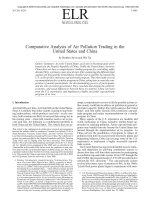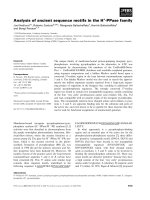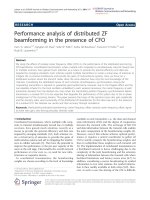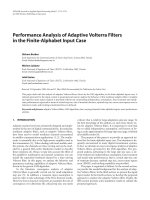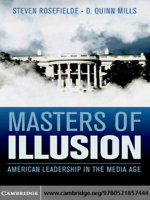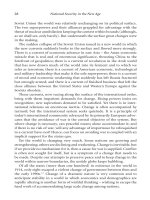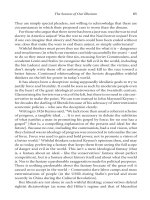Analysis of indian patent regime in the present biotechnology boom
Bạn đang xem bản rút gọn của tài liệu. Xem và tải ngay bản đầy đủ của tài liệu tại đây (1.18 MB, 250 trang )
1
TABLE OF CONTENTS
TABLE OF CONTENTS.......................................................................................................................... 1
SUMMARY ................................................................................................................................................ 3
TABLE OF CASES ................................................................................................................................... 4
CHAPTER I: AN OVERVIEW OF TRADITIONAL KNOWLEDGE AND INTELLECTUAL
PROPERTY RIGHTS .............................................................................................................................. 6
1.1 INTRODUCTION ................................................................................................................................. 6
1.3 BIOPIRACY...................................................................................................................................... 24
1.3.1 Case Study: Turmeric ............................................................................................................. 27
1.3.2 Case Study: Neem................................................................................................................... 28
1.3.3 Case Study: Basmati............................................................................................................... 31
1.4 APPLICATION OF CONVENTIONAL IPRS ON TRADITIONAL KNOWLEDGE .................................... 36
1.4.1 Patents, TRIPS and traditional knowledge ............................................................................ 37
1.4.2 Other forms of IPRs and traditional knowledge.................................................................... 46
1.5 SOCIAL IMPACT OF PATENTING TRADITIONAL KNOWLEDGE........................................................ 49
1.6 PROTECTION .................................................................................................................................. 52
1.6.1 Methods of Protection ............................................................................................................ 57
CHAPTER II: DEFENSIVE PROTECTION OF TRADITIONAL KNOWLEDGE .................... 60
2.1 INTRODUCTION ............................................................................................................................... 60
2.2 PRIOR ART ..................................................................................................................................... 61
2.2.1 The legal position ................................................................................................................... 62
2.2.2 Recommendations and Conclusion ........................................................................................ 68
2.3 DATABASES ................................................................................................................................... 73
2.3.1 Legal Protection of Databases............................................................................................... 76
2.3.2 Endeavours in India................................................................................................................ 89
2.3.3 Advantages of traditional knowledge databases ................................................................... 93
2.3.4 Criticism of the traditional knowledge databases ................................................................. 93
2.3.5 Recommendations................................................................................................................... 97
2.3.6 Conclusion ............................................................................................................................ 100
2.4 COMPULSORY DISCLOSURE OF ORIGIN ..................................................................................... 103
2.4.1 Challenges in Disclosure of Origin...................................................................................... 113
2.4.2 Conclusion ............................................................................................................................ 116
2.5 PRIOR INFORMED CONSENT ....................................................................................................... 117
2.5.1 Challenges in obtaining PIC ................................................................................................ 124
2.5.2 Case Study: The Jeevani experience .................................................................................... 125
2.5.3 Recommendations and conclusion ....................................................................................... 127
2.6 CONCLUSION ................................................................................................................................ 129
CHAPTER III: POSITIVE PROTECTION OF TRADITIONAL KNOWLEDGE .................... 131
3.1 INTRODUCTION ............................................................................................................................. 131
3.2 SUI GENERIS RIGHTS ................................................................................................................... 131
3.2.1 Sui Generis protection systems-legal sanctions................................................................... 137
3.2.2 Geographical Indications (GI)............................................................................................. 144
3.2.3 Other sui generis Indian Acts............................................................................................... 149
3.2.4 Recommendations and Conclusion ...................................................................................... 160
3.3 ACCESS AND BENEFIT SHARING (ABS) .................................................................................... 163
3.3.1 The Bonn Guidelines ............................................................................................................ 164
3.3.2 Relevant provisions in other Indian Legislation.................................................................. 167
3.3.3 Indian benefit sharing instance ............................................................................................ 169
3.3.4 Suggestions and conclusion.................................................................................................. 170
2
3.4 GLOBAL BIOCOLLECTING SOCIETY (GBS) ............................................................................... 172
3.4.1 GBS in India ......................................................................................................................... 177
3.4.2 Conclusion ............................................................................................................................ 180
3.5 CONCLUSION ................................................................................................................................ 181
CHAPTER IV: PATENTABILITY OF MODERN BIOTECHNOLOGY INVENTIONS IN
INDIA...................................................................................................................................................... 183
4.1 INTRODUCTION ............................................................................................................................. 183
4.1.1 Classification of modern biotechnology .............................................................................. 185
4.2 DIAMOND V. CHAKRABARTY ....................................................................................................... 188
4.3 RELAXIN ....................................................................................................................................... 193
4.4 ONCOMOUSE ................................................................................................................................ 196
4.5 ETHICAL ISSUES OF BIOTECHNOLOGY PATENTING IN INDIA ...................................................... 202
4.5.1 India and Article 27(3)(b) .................................................................................................... 203
4.6 INDIA’S PATENT POLICY PRIOR TO TRIPS AND SUBSEQUENT DRIVERS FOR CHANGE .............. 210
4.7 PATENT (AMENDMENT) ACT 2005 ............................................................................................. 218
CHAPTER V: CONCLUDING OBSERVATIONS.......................................................................... 224
BIBLIOGRAPHY.................................................................................................................................. 232
3
Summary
The Truman declaration divided the world into the “developed” and
“underdeveloped”. Save those living in USA, Europe, Japan and few other countries,
most human beings became citizens of the Underdeveloped World as the wholesale
march towards development, Western style, became the mantra for progress that was
almost entirely indifferent to nature. The ensuing large-scale environmental disorders
have brought this Baconian model of growth and development to the brink. It has also
provided a fresh opportunity for traditional knowledge, culture and wisdom to come
to the forefront of decision-making by consumer sectors. India, with its rich repertoire
of such a traditional knowledge base, has a definite edge while preparing its own
roadmap for sustainable development and poverty alleviation. Wizening from
biopiracy episodes and for promoting investment in biotechnology, the Indian
government has spruced up the patent legislation. The instant thesis highlights the
efficacy of the methods of protecting traditional knowledge and analyses the new
provisions introduced in Indian statute laws for preservation and promotion of
traditional technology and encouragement for investment in modern biotechnology. It
is seen that while there has been movement in enactment of legislation, there are
latches and ambiguities which need to be clarified. The problems of unclear
definitions, overlapping and sometimes contradictory provisions in the new laws,
when rectified, would lead to stronger protection for traditional knowledge and
genetic resources, and a generally more robust patent regime in India.
4
TABLE OF CASES
CASE
PAGE
Basmati patent case
30
Bellsouth Advertising & Publishing Corp v. Donnelly Information
Publishing Inc and another 999 F2d 1436 (11th Cir. 1993) 1445
77
Blacklock v. Pearson [1915] 2 Ch. 376
37
British Horseracing Board Ltd v William Hill Organisation Ltd Case C203/02
Burlington Home Shopping v. Rajnish Chibber 1995 PTC (15) 278
82
Catnic Components Ltd and Another v. Hill & Smith Ltd. [1982] RPC
183
70
CCH Canadian Ltd. v. Law Society of Upper Canada [2004] S.C.C. 13
85
Commissioner of Patents v. President and Fellows of Harvard College
and Ors. 2002 SCC 76
187,196
Diamond v. Chakrabarty 447 U.S. 303 (1980)
84
43,187,188
Dimminaco AG v. Controller of Patents and Designs. & Others,(Aid
No.1 of 2002)
191,205
Eastern Book Company v. Navin J. Desai A.I.R. 2001 Delhi 185.
85,102
Feist Publications v. Rural Telephone Service 499 US 340, 113 L Ed 2d
358, 11 S Ct 1282 (1991)
77,80,102
Fomento Industrial S.A. Biro Swan Ltd. v. Mentmore Mfg. Co. Ltd.
(1956) RPC 87
65,66
Foster v. Mountford (1976) 29 FLR 233
47,69
Himalaya Drug Company v. Sumit Suit No.S-1719 of 2000
88,102
Howard Florey /Relaxin [1995] EPOR 541
187,193
Improver Corporation v. Remington Consumer Products Ltd [1990] FSR
181
70
Institute National Des Appellations v. Brown-Forman Corp., 47 USPQ2d
1875, (TTAB 1998)
145
Kelly v. Morris (1866) L.R. 1 Eq. 697
37
5
Lallubhai Chakubhai v. Chimanlal & Co. (1935) A.I.R. 1936 Bombay 99
65
Matthew Binder & Co. v. West Publishing Co. (158 F.3d 674, 48
U.S.P.Q. 2d (BNA) 1560 (2d Cir. 1998); 158 F. 3d 693, 48 U.S.P.Q. 2d
(BNA) 1545 (Cir.1998)
77
Merck & Co Inc v. Pharmaforte Singapore Pte Ltd, [2000] 3 SLR 717
70
Merrell Dow Pharmaceuticals Inc.v. H N Norton & Co. [1996] R.P.C.
76, HL
12
Monsanto Canada Inc. v. Schmeiser, [2004] 1 S.C.R. 902, 2004 SCC 34
(CanLII)
52,199
Moore v. Regents of the University of California 793 P.2d 479
204
Mother's Restaurant v. Mother's Other Kitchen, Inc., 218 U.S.P.Q. 1046
(TTAB 1983)
33
Neem patent case
98,62,71
Plant Genetic Systems/Glutamine Synthetase Inhibitors (T356/93) [1995]
E.P.O.R. 357
203
P.L.G. Research Ltd. v. Ardon International Ltd. [1993] F.S.R. 197
64
Scotch Whiskey Association v. Pravara Sakhar Shakar Karkhana Ltd
A.I.R. 1992 Bombay 294
147
Societe Technique De Pulverisation Step v. Emson Europe (1993) RPC
513 (CA)
70
Telstra Corporation Limited v. Desktop Marketing Systems Pty Ltd
[2001] 51 I.P.R. 257
80
Turmeric patent case
26
University of London Press v. University Tutorial Press [1916] 2 Ch. 601
81
Warren Publishing Inc. v. Microdos Data Corp and others (522 US 963
(1997))
77
V.Govindan v. E.M.Gopalakrishna and Anr AIR 1955 Madras 391
84
6
CHAPTER I:
KNOWLEDGE
RIGHTS
AN OVERVIEW OF TRADITIONAL
AND INTELLECTUAL PROPERTY
1.1 INTRODUCTION
The Egyptian rulers, during their imperial expeditions were known to bring back
exotic foliage from different nations with them. One of the earliest recorded plant
hunting expeditions took place 5000 years ago when Pharaoh Sankhkara sent ships to
Gulf of Aden to collect cinnamon and cassia used for embalming the dead.1 The
recent years witnessed a different form of trade in foliage and genetic material.
Farnsworth, the distinguished pharmacognosist, indicated that in 1980 a quarter of the
prescriptions dispensed from community pharmacies in the United States2 contained
active principles from the higher plants.3 Rapid growth of new technologies in genetic
engineering and biotechnology has led to an increased commercial interest in the
wealth of biological resources and the traditional knowledge of developing nations.
India has been one of the world’s biologically and culturally diverse countries.4 India
is also one of the most advanced developing countries in terms of scientific
capabilities, including the life sciences.5 She is the only developing country to appear
1
JUMA CALESTOUS, THE GENE HUNTERS: BIOTECHNOLOGY AND THE SCRAMBLE FOR
SEED, (1989) 38.
2
Hereinafter referred to as US.
3
N.R. FARNSWORTH, Pharmaceutical Technology, (August 1995) 14.
4
India is one of the 12-mega diverse countries of the world. With only 2.5% of the land area, India
already accounts for 7.8% of the global recorded species. India is also rich in traditional and indigenous
knowledge, both coded and informal. See, National Biodiversity Authority website at
< > (last accessed on 5 July 2005).
5
According to Lall, India had 869,000 tertiary-level students of natural sciences in 1990. S LALL,
Technological Change and Industrialization in the Asian Newly Industrializing Economies:
Achievements and Challenges, in TECHNOLOGY, LEARNING AND INNOVATION:
EXPERIENCES OF NEWLY INDUSTRIALIZING ECONOMIES: ACHIEVEMENTS AND
CHALLENGES (L. Kim & R. Nelson eds., 1990) 13-68 at 44.
7
in a survey of top ten countries for industrial literature citations.6 Although India has
developed research capabilities in a broad range of biotechnologies and biotechnology
applications,7 awareness about intellectual property rights has historically been poor
in India.
The developed countries have complained that intellectual property rights8 protection
is weak in India, thereby deterring them from investing in research there.9 However,
the last decade has been the era of activity in the field of intellectual property rights in
the country. After the ratification of the Agreement on Trade Related Aspects of
Intellectual Property Rights,10 there have been three amendments to the Indian Patent
Act of 1970. In a bid to protect the vast traditional knowledge and related genetic
resources, provisions have been introduced in the Indian Patent Act, and further Acts
6
P K B MENON, Development of New Generic Technologies in India, in NEW GENERIC
TECHNOLOGIES IN DEVELOPING COUNTRIES (M R Bhagavan ed., 1997) 99.
7
In fact Ranbaxy, an Indian pharmaceutical company, has sued Novartis on its own turf, in United
States. For further discussion see Section 4.1 Chapter IV of the thesis.
8
Hereinafter also referred to as IPR / IPRs.
9
The Indian press had highlighted the findings of the recent World Bank Development Report, which
claims that "at least 25 per cent of global chemical and pharmaceutical companies are unwilling to
invest in India as the protection offered to intellectual property rights (IPR) by New Delhi is too
inadequate to allow them to transfer the latest and effective technologies."
Source: The Hindu Business Line, Mumbai, October 5, 1998, 9.
10
Agreement on Trade Related Aspects of Intellectual Property Rights (hereinafter referred to as TRIPS
): The final round of the multilateral trade negotiations which had commenced at Uruguay culminated
at the Marrakesh Ministerial held at Marrakesh, Morocco in December 1993 with the establishment of
the World Trade Organization (WTO). To standardize the IPR regimes, the members of the WTO
signed the multilateral agreement Trade-Related Aspects of Intellectual Property Rights (TRIPS) in the
same ministerial. The TRIPS aimed to achieve a global intellectual property rights regime through the
following methods: -the broadening of existing rights; -the creation of new (sui generis) rights;-the
progressive standardization of the basic features of IPR. TRIPS efforts toward harmonizing the IP
regimes in the member states are evident through its various articles. By Article 3, the members
accepted the principle of ‘National Treatment’ whereby each member state is required to provide
similar IP protection to the right holders irrespective of their nationality. Article 4 lays down the ‘Most
Favoured Nation’ principle whereby any favour or concession granted by a state to any other state
should be extended to all the other member states of the WTO. It is presently the most relevant treaty
on global IPR regimes. A detailed discussion is available inter alias at Chapter IV.
8
have been legislated. The present thesis is a study of the current patent scenario in
India.
The major concern India has shared with some of the biodiverse developing nations is
the protection of traditional knowledge. Not only are these issues of concerns within
hard intellectual property law, but also raise important development and social issues
as Convention on Biological Diversity demonstrates. In Chapter I of the thesis,
definitions and classifications of traditional knowledge have been stated.
Subsequently instances of disputes regarding unauthorized exploitation of genetic
resources and associated traditional knowledge have been discussed. This is followed
by a comprehensive study of the impact of patenting traditional knowledge; the
suitability of standard intellectual property11 laws to protect traditional knowledge and
positive and defensive methods of protecting traditional knowledge.
Chapter II begins with an analysis of the problems of having a non uniform definition
of “prior art” for assessing the novelty of an invention. This is followed by
discussions on traditional knowledge databases and India’s efforts to establish such
databases; and; compulsory disclosure of origin and prior informed consent as two
defensive methods for protecting traditional knowledge and India’s initiatives in these
regards.
Chapter III discusses positive protections to traditional knowledge: developing sui
generis rights for traditional knowledge, access and benefit sharing provisions
between the traditional knowledge holders and the bio prospectors with an Indian
11
Hereinafter also referred to as IP.
9
example of benefit sharing with Kani tribe and finally the efficacy of establishment of
Global Bio-collecting Society, suggested by Peter Drahos, in the Indian context.
Aside from protecting traditional knowledge and taking into account interests of
indigenious people, India aspires to participate in modern day biotechnology of food
and medicines. Chapter IV deals with some issues relating to the modern
biotechnological inventions and India’s probable position in case of patenting of third
generation biotechnology inventions. It concludes with a brief overview of the
relevant changes in the Patent (Amendment) Act 2005.
Evolution of Patent Act in India
According to W.R.Cornish, “Patents are rights granted in respect of inventions, i.e.
technological improvements, great and small, which contain at least some scintilla of
inventiveness over what is known”.12 It has a prohibitive tenor as well.13 Patent
precludes anybody but the inventor or his authorized person to use the patented
invention without the inventor’s permission or without paying royalty to the
inventor.14 Like other proprietary rights, a patent allows the patent-holder to exercise
12
WILLIAM CORNISH & DAVID LLEWELEYN, INTELLECTUAL PROPERTY: PATENTS,
COPYRIGHTS, TRADEMARKS AND ALLIED RIGHTS, (5th ed. 2003) ¶ 1-05.
13
A literal translation of the Latin litterae patents, letters patent referred to open letters or official
documents by which certain privileges, rights, ranks or titles were conferred by sovereign rulers.
Letters patent were first issued in the sixth century in Europe for discovery and conquest of foreign
lands on their behalf. This has prompted them to be called instruments of “colonization” by Vandana
Shiva, a noted scholar and environmentalist in India. See, Nic Paget-Clarke, An Interview with Dr.
Shiva, at < > (last accessed 3 August 2004).
14
Patent is “The right which they accord is to prevent all others—not just imitators, but even
independent devisers of the same idea—from using the invention for the duration of the patent”. See,
supra note 12.
10
monopoly over his property, the invention, for a stipulated period subject to the
restrictions imposed by the other laws of the land.15
The first legislative enactment on patents in India granting “exclusive privileges”16 to
inventors for a period of 14 years was Act VI of 1856. The Indian Patents and
Designs Act of 1911 repealed all the previous pieces of legislation regarding patents
in India. During 1911 and 1970, in bids to improvise patent legislation, various
amendments were introduced. In 1957, Government of India set up the Ayyangar
Committee under Justice Rajagopala Ayyangar for suggestions regarding revision of
patent law. Justice Ayyangar submitted his report in 1959, which, overcoming various
impediments developed into the Patents Act, 1970, the present statute on patents in
India. The Act, along with Patent Rules came into force on 20th April 1972.
India joined World Trade Organization17 in 1994 and TRIPS Agreement was
promulgated in 1995. In July 1996, US initiated WTO dispute settlement procedures
over India's failure to implement its TRIPS obligations, namely setting up of mailbox
facilities and granting Exclusive Marketing Rights.18 The European Union19 made a
15
For instance, the owner of a patent of a new medicine can not market the medicine without
appropriate permissions from other authorities, namely, the drug controller, and in case the medicine is
to be administered orally, the food department.
16
The “exclusive privileges” included the rights of making, selling, licensing and using the invention in
India for a period of 14 years. The Act of 1856 was modified and re-enacted as Act XV of 1859. This
Act was followed by the Patterns and Designs Protection Act, 1872 and Protection of Inventions Act in
1883. These two Acts were further modified by the Inventions and Designs Act of 1888.
17
World Trade Organization (also and hereinafter referred to as WTO): The World Trade Organization
is an international body overseeing trade agreements among its 148 member states. Established in
1995, after a series of trade negotiations, the WTO functions as a forum for discussing existing and
new trade rules and as a dispute settlement body among the member states. More about WTO can be
found in the official home page at < > (last accessed 3 October 2005).
18
TRIPS Article 70.8 (mailbox provision) requires a country such as India, which did not provide
product patent protection to pharmaceutical products on January 1, 1995, to establish, starting on that
date, a system that will permit innovators to file patent applications for such products. In addition, once
the conditions of Article 70.9 are met, the product that is the subject of the patent application that was
registered in the mailbox will be granted "exclusive marketing rights" if it was not yet patentable.
Exclusive marketing rights are also, and hereinafter in the thesis referred to as EMRs.
11
similar complaint on 1st April 1997. The final panel report on this case was issued in
August 1997 wherein it was held that India had failed to meet her obligations under
the TRIPS. In 1998, India joined the Patent Co-operation Treaty20, and a chapter was
added to Patent Rules 1972 providing for filing of international patent applications in
India under the PCT. To comply with the WTO ruling, The Patent (Amendment) Act
1999 was passed in March 1999, including Exclusive Marketing Rights21 and
establishing a mailbox to receive foreign patent applications.22 Subsequently the
Patent Act was amended in 200223 and 2004.24 The Patents Amendment Act 2005,
Article 70.8, TRIPS: Where a Member does not make available as of the date of entry into force of the
WTO Agreement patent protection for pharmaceutical and agricultural chemical products
commensurate with its obligations under Article 27, that Member shall: (a) notwithstanding the
provisions of Part VI, provide as from the date of entry into force of the WTO Agreement a means by
which applications for patents for such inventions can be filed; (b) apply to these applications, as of the
date of application of this Agreement, the criteria for patentability as laid down in this Agreement as if
those criteria were being applied on the date of filing in that Member or, where priority is available and
claimed, the priority date of the application; and (c) provide patent protection in accordance with this
Agreement as from the grant of the patent and for the remainder of the patent term, counted from the
filing date in accordance with Article 33 of this Agreement, for those of these applications that meet the
criteria for protection referred to in sub paragraph (b).
19
Hereinafter also referred to as EU.
20
Patent Cooperation Treaty (hereinafter referred to as PCT): The Patent Cooperation Treaty is a
multilateral agreement that provides for filing of an international application when protection is sought
for an invention in several countries. The Treaty was concluded in 1970, amended in 1979, and
modified in 1984 and 2001. The membership to the Treaty is open to the Paris Convention member
countries. As per Article 3, patent aspirants of contracting states of PCT can simultaneously obtain
priority for their inventions without having to file separate application in their countries of interest. In
addition the system provides much longer time for filing patent application in member countries. The
time available under Paris Convention for securing priority in other countries is 12 months from the
date of initial filing. Under the PCT, the time available could be as per Article 22(1), maximum 30
months. Further, an inventor is also benefited by the search report prepared under the PCT system to be
sure that the claimed invention is novel. As per Article 31, the inventor can also opt for preliminary
examination before filing in other countries to be doubly sure about the patentability of the invention.
The text of the Treaty is at < > (last accessed 1 September
2005).
21
Also known as EMRs.
22
The Patent (Amendment) Ordinance was passed in January 1999, which became an Act in March
1999. Chapter IVA Sections 24A-D of the Patents Amendment Act 1999 provided for EMRs.
23
As per Section 48(a) of the Indian Patents Act, 1970 as amended in 2002 a patent confers on the
owner the exclusive right by himself, his agents, assignees or licensees to prevent any third party,
without explicit authorization, from making, using, offering for sale, selling or importing for these
purposes the patented product. This is in conformity with Article 28(1)(a) of the TRIPS Agreement. In
the case of the grant of a patent for a method or process of manufacture, this right extends to the
‘product obtained directly by the patented process. See, Section 48(b), the Patents act, 1970 as
amended in 2002. This is in conformity with Article 28(1)(b) of TRIPS.
24
Sources: P.NARAYANAN, INTELLECTUAL PROPERTY LAW, (3rd ed., 1998), 9-15;
RAJIV JAIN & RAKHEE BISWAS, LAW OF PATENTS, (2d ed. 1999), 1.1 - 1.10.
12
amending the Patent Act of 1970, has been passed by the Upper House of the Indian
Parliament and is now the Act in force for patents in India.25
1.2 Traditional knowledge
About 80 percent of the world’s population relies on traditional medicines in some
way. 26 Reliance may be due to the costs or cultural choice. Traditional
biotechnological knowledge has developed among the indigenous community and has
been disseminated by the traditional medical practitioners to the incumbents. Its
present importance is twofold.
First, it is estimated that over one-third of the world’s population lacks regular access
to affordable essential drugs. Traditional medicine is widely available, accessible and
affordable to most people. It is still a widely practiced way of medical treatment in
various parts of the world.
Second, the high possibility of future drugs being based on traditional plant remedies
is in large part rooted in the fact that precedents exist in the discovery of aspirin,
antibiotics and quinine.26 There have been various attempts subsequently to
25
Patent Amendment Ordinance 2004 was passed by the Indian Parliament on 26 December 2004. The
Ordinance was ratified into an Act by the Parliament on 24 March 2005. See, Patent Legislation
Passed, March 2005, at < > (last
accessed on 19 September 2005).
26
Lord Hoffman summarises the procedure behind the discovery from drugs from natural ingredients.
In the judgement in the case of Merrell Dow v. Norton, his Lordship wrote, “The Amazonian Indians
have known for centuries that cinchona bark can be used to treat malaria and other fevers. They used it
in a form of powdered bark. In 1820, French scientists discovered that the active ingredient, an alkaloid
called quinine, could be extracted and could be used more effectively in the form of sulphate of
quinine. In 1944, the structure of alkaloid molecule (C20H24N2O2) was discovered. This meant that the
substance could be synthesized. Imagine a scientist telling an Amazonian Indian about the discoveries
of 1820 and 1944. He says: “We have found the reason why the bark is good for fevers is that it
contains an alkaloid with a rather complicated chemical structure which reacts with the red corpuscles
in the bloodstream. It is called quinine.” The Indian replies: “That is very interesting. In my tribe, we
13
manufacture drugs from natural ingredients on the basis of information based on
traditional knowledge.
The following two tables illustrate some relevant figures.27
Global Sales for Products Derived from Genetic Resources, 1997 (USD in billion)28
Product
USDbn
Botanical medicines
20+
Ornamental horticultural produce
16-19
Agriculture produce
300-450+
Commercial agricultural seed
30
The following table shows the total global gross sales in these industries and the
component of product sales that are of natural origin.
Estimated Global sales in the Pharmaceutical, Personal Care and Cosmetics, And Crop
Protection Industries, and Component of Products derived from Genetic Resources, 1997 (USD
bn)
Product
USD bn
Pharmaceuticals
300
Personal care and
cosmetics
55
Crop protection
30
Sales of natural origin
(USD bn)
75(using a conservative
25%)
2.8+
0.6-3
The highest seller in the aforesaid tables, traditional pharmaceutical products, falls
under the genus of traditional knowledge which includes other forms of knowledge
call it the magic spirit of the bark.” ” He held that if a particular usage of a substance was known, nonidentification of the active ingredient causing the particular usage would not prevent it from forming
part of prior art. Merrell Dow v. H N Norton & Co. [1996] R.P.C. 76, HL.
27
The tables have been cited from: KERRY TEN KATE & SARAH A LAIRD, THE COMMERCIAL
USE OF BIODIVERSITY: ACCESS TO GENETIC RESOURCES AND BENEFIT SHARING,
(Repr. ed., 2000) 315.
28
The aforesaid figures relate to certain products which are solely derived from genetic resources.
There are some products which could have been produced using various components not involving
genetic resources. Only a proportion of these products are derived from genetic resources.
14
like folklore and trade secrets. For protecting traditional knowledge, it is necessary to
devise a definition of the knowledge that would be protected under this category.
Some endeavours regarding defining traditional knowledge are being enumerated in
the following discussion.29
Blakeney30 has said that the intellectual creations of the traditional communities were
initially classified as “folklore”. Subsequently World Intellectual Property
Organization,31
and
United
Nations
Educational,
Scientific
and
Cultural
Organization,32 convened a ‘Group of Experts on the Protection of Expressions of
Folklore by Intellectual Property’ who discussed the appropriate terminologies in this
context. In the meeting held in Paris in December, 1984, objection to the use of the
29
Singapore, for instance, noted that the fact that there was no clear consensus as to the specific scope
of traditional knowledge hindered discussions regarding commitments is this area. Singapore position
on TRIPs: Non-Paper by Singapore, Council for Trade-Related Aspects of Intellectual Property Rights,
JOB(00)/7853, 11 December 2000. Also see The CIPR (Commission of Intellectual Property Rights)
Report of September, 2002. The CIPR has held that there is no widely accepted definition of traditional
knowledge. It is a combination of a wide range of concerns and objectives. CIPR, Integrating
Intellectual Property Rights and Development Policy, Report of the Commission of Intellectual
Property Rights, September 2002, 75, 78.
30
Michael Blakeney; The Protection of Traditional Knowledge under Intellectual Property Law,
[2000] E.I.P.R., 251.
31
World Intellectual Property Organization (commonly known as and hereinafter referred to as WIPO
in the instant thesis) is one of the 16 specialized agencies of the United Nations system of organizations
dealing with the promotion and protection of intellectual property. Based in Geneva it was established
under a treaty, “ The Convention Establishing the World Intellectual Property Organization of July 14,
1967” It operates under United Nations Education, Scientific and Cultural Organization (UNESCO)
and entered into force in 1970. The treaty was subsequently amended in 1979 and 2000. At present it
has 183 signatories. See, G.GREGORY LETTERMAN, BASICS OF INTERNATIONAL
INTELLECTUAL PROPERTY LAW, (2001) 26-27. Also see, About WIPO, at
( last accessed on 22 July 2005) and Member States,
at ( last accessed on 25 April 2006).
32
United Nations Educational, Scientific and Cultural Organization (commonly known as and
hereinafter referred to as UNESCO in the instant thesis) is an agency under the United Nations. It was
estbalished in 1946 and is headquartered in Paris, France, with over 50 field offices and several
institutes and centres throughout the world. The Organization’s main objective is to contribute to peace
and security by promoting collaboration among the nations through education, science and culture in
order to further universal respect for justice, for the rule of law and for the human rights and
fundamental freedoms (Article 1 of UNESCO’s Constitution). 191 nations belong to UNESCO.
UNESCO pursues its action through five major programmes: education, natural sciences, social &
human sciences, culture and communication & information. Projects sponsored by UNESCO include
literacy, technical, and teacher-training programmes; international science programmes; regional and
cultural history projects, the promotion of cultural diversity; international cooperation agreements to
secure the world’s cultural and natural heritage and to preserve human rights. More about the
organization can be found at the UNESCO website at www.unesco.org (last accessed on 3 July 2005).
15
term “folklore” was raised on the ground that the term implied “a negative
connotation of being associated with the creations of lower or superseded
civilizations”.33 However, the objections being superseded, the 1985 meeting
provided an inclusive definition for “Expressions of Folklore” which read as follows:
“(…) “expressions of folklore” mean productions consisting of characteristic elements
of the traditional artistic heritage developed and maintained by a community, or by
individuals reflecting the traditional artistic heritage developed and maintained by a
community, in particular:
(i)
verbal expressions, such as folk tales, folk poetry and riddles;
(ii)
musical expressions, such as folk songs and instrumental music;
(iii)
expressions by action, such as folk dances, plays and artistic forms or
rituals, whether or not reduced to a material form; and
(iv)
tangible expressions, such as
(a) production of folk art, in particular, drawings, paintings, carvings,
sculptures,
pottery,
terracotta,
mosaic,
woodwork,
metalware,
jewellery, basket weaving, needlework, textiles, carpets, costumes;
(b) musical instruments;
(c) architectural forms.”34
This terminological approach was the subject of an in-depth discussion at the World
Forum on the Protection of Folklore, convened by WIPO and UNESCO in Phuket,
Thailand in April 1997.35 The aforesaid definitions had remained functional till
33
“Report”, Copyright: Monthly Review of the World Intellectual Property Organization, 1985, 41, ¶
22.
34
Id. at 47-48.
35
The Forum was convened in response to the recommendations in February 1996 of the WIPO
Committee of Experts that arrangements be made for the organization of an international forum to
16
objections to the use of the term “folklore” for referring to all indigenous knowledge
were raised at the above conference. It was pointed out that the definition failed to
include all aspects of life of the indigenous people, including their scientific
knowledge.36 The term “traditional knowledge” was coined to address the lapses of
the term “folklore”. A major distinction was that, folklore, chiefly dealing with artistic
expressions, is discussed in terms of copyright protection, while traditional
knowledge, involving scientific knowledge including inventions, is considered in
terms of other form of intellectual property protection, particularly patents.37
Attempts to define traditional knowledge have been made by various international
conventions. The various conventions have used the terms ‘traditional knowledge’
and ‘indigenous knowledge’ in different contexts. Significant work has been done on
this subject by WIPO in response to the need for greater clarity in respect of
terminology and the subject matter covered under it.38 The WIPO Secretariat made
explore “issues concerning the preservation and protection of expressions of folklore, intellectual
property aspects of folklore and the harmonization of different regional interests”.
36
Unesco-WIPO World Forum on the Protection of Folklore, UNESCO/WIPO/FOLK/PKT/97/1,March
17, 1997 at < > (last accessed on 3 June
2004).
37
Blakeney, supra note 30 at 252.
38
Discussions regarding selecting suitable terminologies were held by the Intergovernmental
Committee on Intellectual Property and Genetic Resources, Traditional knowledge and Folklore in
their preliminary meetings. WIPO established the Intergovernmental Committee (IGC) on Intellectual
Property and Genetic Resources, Traditional Knowledge and Folklore in October 2000 to discuss and
debate issues relating to traditional knowledge, genetic resources and folklore. Along with the WIPO
members, independent bodies and non-governmental organizations can also participate in the IGC
proceedings as observers. The functions of the IGC include policy debate, reports on national
experiences, empirical surveys, exchange of experience of indigenous and local communities, analysis
of legal and policy options for enhanced protection of traditional knowledge, crafting specific practical
tools, development of recommendations for revision of the international patent system to take account
of traditional knowledge, and capacity building and awareness initiatives. The IGC has met 8 times
since inception, the last meeting being in Geneva in June 2005. More about the IGC can be found at
the WIPO website, at < > (last accessed on 24 June 2005). Also see,
< WIPO/GRTKF/IC/3/9, at > last accessed on 24 June
2005).
17
use of the following working concept of ‘traditional knowledge’ for the purposes of
the fact-finding missions in 1998-1999:39
“Traditional Knowledge’ … refer[s] to tradition-based literary, artistic or scientific
works; performances; inventions; scientific discoveries; designs; marks, names and
symbols; undisclosed information; and all other tradition-based innovations and
creations resulting from intellectual activity in the industrial, scientific, literary or
artistic fields”.
This definition further explains that “tradition-based” refers to “knowledge systems,
creations, innovations and cultural expressions which have generally been transmitted
from generation to generation; are generally regarded as pertaining to a particular
people or its territory; and, are constantly evolving in response to a changing
environment.”
The Convention on Biological Diversity40 has provided an alternative description of
traditional knowledge in its provisions. Article 8(j) of the CBD provides for each
39
Inter-Governmental Committee on Intellectual Property and Genetic Resources, Traditional
knowledge and Folklore, at
< (last
accessed on 13 December 2004).
40
The Convention on Biological Diversity (commonly known as and hereinafter referred to as CBD in
the instant thesis) entered into force on 29 December 1993. It is the outcome of the Earth Summit in
Rio de Janeiro, Brazil in 1992. It contains three national level obligations: to conserve, to sustainably
use, and to share the benefits of biological diversity. Other aspects of biodiversity such as in situ and ex
situ conservation of wild and domesticated species; access to genetic resources and technology,
including biotechnology; new and additional financial resources, and safety of release or
experimentation on genetically-modified organisms, also known as bio-safety were included in the
convention. Parties to the Biodiversity Treaty “affirm sovereign rights over the biological resources
found within their countries, while accepting responsibility for conserving biological diversity and
using biological resources in a sustainable manner,” according to an International Union for the
Conservation of Nature (IUCN) assessment of the treaty. The treaty, in its article on objectives,
commits Parties to “fair and equitable sharing of the benefits arising out of the utilization of genetic
resources.” Other Articles of the Convention discuss Access to Genetic Resources, Access to and
Transfer of Technology, and Handling of Biotechnology and Distribution of its Benefits. India has
been a member of the treaty since 1994. For full text see CBD website, at
< (last accessed on 4 September 2005).
18
contracting party to incorporate in its domestic legislation, the following definition of
traditional knowledge: “(…) knowledge, innovations and practices of indigenous and
local communities embodying traditional lifestyles (…)”.41 CBD explains that
traditional knowledge has “[d]eveloped form experience and gained over the centuries
and adapted to the local culture and environment, traditional knowledge is transmitted
orally form generation to generation.”42 Characterizing traditional knowledge, CBD
states, “it [traditional knowledge] tends to be collectively owned and takes the form of
stories, songs, folklore, proverbs, cultural values, beliefs, rituals, community laws,
local language, and agricultural practices, including the development of plant species
and animal breeds.”
CBD, in a separate document, has qualified “traditional knowledge” to be a “term
used to describe a body of knowledge built by a group of people through generations
living in close contact with nature. It includes a system of classification, a set of
empirical observations about the local environment, and a system of self-management
that governs resource use (…). In the context of knowledge, innovation is a feature of
indigenous and local communities whereby tradition acts as a filter through which
innovation occurs.
In this context, it is traditional methods of research and
application and not always particular pieces of knowledge that persist. Practices
should therefore be seen as the manifestations of knowledge and innovation”.43
41
Convention of Biological Diversity, Article 8(j): Traditional Knowledge, Innovations and Practices:
Introduction, at < > (last accessed
on 4 September, 2005).
42
id.
43
Convention of Biological Diversity, Traditional Knowledge And Biological Diversity: Note by the
Executive Secretary, UNEP/CBD/TKBD/1/2, Hague, 18 October 1997, ¶¶ 84, 86.
19
It should be kept in mind that WIPO and CBD have different accents. While the
former strives to promote “simpler, cheaper and more secure” intellectual property
protection throughout the world,44 the later aims to achieve conservation and
sustainable development of world biodiversity.45 The definition of WIPO has a
comparatively wider scope as it explicitly recognizes that traditional knowledge is
“constantly evolving”46.
The UNESCO and the WTO have offered other significant definitions of traditional
knowledge. These are:
•
“The traditional knowledge and expressions of indigenous cultures are defined
as the ways in which indigenous cultures are expressed and which are manifestations
of worldviews of the indigenous peoples of the Pacific. Traditional knowledge and
cultural expressions are any knowledge or any expressions created, acquired and
inspired (applied, inherent or abstract) for the physical and spiritual well-being of the
indigenous peoples of the Pacific. The nature and use of such knowledge and
expressions are transmitted from one generation to the next to enhance, safeguard and
perpetuate the identity, well-being and rights of the indigenous peoples of the
Pacific”.47
44
World Intellectual Property Organization, WIPO’s Vision, at < > (last accessed on 3 September 2004).
45
Convention of Biological Diversity, Sustaining Life on Earth: How the Convention on Biological
Diversity promotes nature and human well-being , at
< > (last accessed on 3 September 2004).
46
World Intellectual Property Organisation, Inter-Governmental Committee on Intellectual Property
and Genetic Resources, Traditional knowledge and Folklore, at
< knowledgefic3_9.doc > (last
accessed on 15 August 2004).
47
UNESCO Symposium on the Protection of Traditional knowledge and Expressions of Indigenous
Cultures in the Pacific Islands, Noumea, 15-17 February 1999: Final Declaration, at
<www.unesco.org/culture/copyright/folklore/html_eng/declaration.shtml> (last accessed on 3
September 2004).
20
•
“Traditional knowledge consists largely of innovations, creations and cultural
expressions generated or preserved by its present possessors, who may be defined and
identified as individuals or whole communities, natural or legal persons, who are
holders of rights. The economic, commercial and cultural value of this traditional
knowledge for its possessors warrants and justifies a legitimate interest that this
knowledge be recognized as a subject matter of intellectual property”.48
“Indigenous knowledge” is either used to describe knowledge held and used by
communities, peoples and nations that are indigenous, or to denote knowledge which
is itself indigenous, in the sense of specifically originating in a certain region or
country, that is, “indigenous means belonging to, or specific to, a particular place”.49
Whichever sense of ‘indigenous knowledge’ is used, the general usage seems to
suggest that all indigenous knowledge is traditional knowledge, although it is likely
that some traditional knowledge may not have the specific characteristic of being
“indigenous”.50 There are again several definitions for the term “indigenous people”,
but essentially the term refers to people who characteristically exist under “conditions
of severe disadvantage relative to others within the states constructed around them.”51
A distinction between traditional knowledge and indigenous knowledge may be
drawn from the example of the codified forms of one of the traditional knowledge
48
World Trade Organization, Proposal on Protection of the Intellectual Property Rights Relating to
the Traditional knowledge of Local and Indigenous Communities: Communication from Bolivia,
Colombia, Ecuador, Nicaragua, and Peru, WT/GC/W/362, WTO, Geneva, 12 October 1999.
49
Graham Dutfield , Comment on the Draft WIPO Report on Fact-finding Missions on Intellectual
Property and Traditional Knowledge: Intellectual Property Needs and Expectations of Traditional
Knowledge Holders (1998-1999) dated December 12, 2000 at < > (last accessed on 3 September 2004).
50
J. Mugabe, “Intellectual Property Protection and Traditional Knowledge,” Intellectual Property and
Human Rights (WIPO, 1999), 97 at 98-99.
51
See, S. JAMES ANAYA, INDIGENOUS PEOPLES IN INTERNATIONAL LAW, (1996) 3.
21
systems in India, the Ayurveda52. The word is a combination of the two Sanskrit
words “Ayu” and “Veda”. The word “Ayu” would mean “life”, (in the sense of living
span) while “Veda” refers to the knowledge. Crudely translated, the word would mean
“the knowledge for long life”. This is a classical codified medical system and is not
folk or developed by indigenous people. Thus traditional medical knowledge system
would not be synonymous to an indigenous knowledge or folk knowledge. Hence
while all indigenous knowledge is traditional, not all traditional knowledge is
indigenous. Dutfield, in his comments on the Draft Report says that “‘Indigenous’
means belonging to, or specific to, a particular place.”53 It is in this sense that the term
‘indigenous knowledge” is used in the instant thesis.
Some have objected to the use of the word ‘traditional’ and have preferred the word
‘customary’ while referring to such knowledge. It has been apprehended that usage of
the word ‘traditional’ would preclude the modern innovations made in the areas.
Further, for establishing antiquity of a particular knowledge, documentary proof
might be sought. The term ‘customary knowledge’ would not involve such issues.54 In
the instant thesis the term “traditional knowledge” is used to comprehend customary
knowledge. The definitions are only a generic description of forms of traditional
knowledge and do not achieve the distinct classification of traditional knowledge.
WIPO has held that the term ‘traditional knowledge’ is a working term only and it
“acknowledges the right of indigenous groups, local communities and other TK
52
R.A. Mashelkar, Protecting intellectual property,at < > (last accessed on 22 June 2005).
53
Dutfield , supra note 49.
54
World Intellectual Property Organization, Traditional Knowledge – Operational Terms and
Definitions, WIPO/GRTKF/IC/3/9,May 20, 2002, ¶ 19, at
< > (last accessed on 3 July
2005).
22
holders to decide what constitutes their own knowledge, innovations, cultures and
practices, and the ways in which they should be defined.”55
To conclude on the subject of overlapping and inadequate definitions of traditional
knowledge, WIPO has observed that different terms may therefore be used for
overlapping subject matter and the same term may be used in contrasting ways, so it
may only be possible or desirable to settle on a particular definition in the context of a
specific legal instrument and with a defined policy goal.56
A more pragmatic approach to treating traditional knowledge is explaining what kinds
of knowledge should be protected. If any protection system is to be established, it is
essential that the subject matter of the protection is clearly identified, as all such
knowledge will need to be documented in some way. Categories of traditional
knowledge could include: agricultural knowledge; scientific knowledge; technical
knowledge;
ecological knowledge;
medicinal knowledge, including related
medicines and remedies; biodiversity-related knowledge; “expressions of folklore” in
the form of music, dance, song, handicrafts, designs, stories and artwork; elements of
languages, such as names, geographical indications and symbols; and movable
cultural properties.57 Excluded from this description of traditional knowledge would
55
World Intellectual Property Organization, WIPO Report on Fact-finding Missions on Intellectual
Property and Traditional Knowledge: Intellectual Property Needs and Expectations of Traditional
Knowledge Holders (1998-1999), 25. ‘TK’ and ‘tk’ are frequently used acronyms of traditional
knowledge.
56
WIPO/GRTKF/IC/3/9, supra note 54 ¶ 15. See also, CIPR, supra note 29.
57
UNESCO, in its thesaurus, puts forward the following classifications of traditional knowledge:
1. Ethno-botany: this field includes cultural environmental resources and indigenous people’s ancestral
remains, human genetic materials. 2. Traditional architecture: this field includes all sites of cultural
significance and immovable cultural property and their associated knowledge. 3. Traditional
technology: this field includes traditional resource management techniques including traditional
conservation measures and scientific, agricultural, technical and ecological knowledge, and the skills
required to implement this knowledge (including that pertaining to resource use practices and systems
of classification). 4. Traditional medicine: this field includes all forms of traditional medicine that is
based on knowledge of diseases and curative methods and therapeutic substances. 5. Traditional
agriculture: this field includes methods and implements used in traditional forms of agriculture and
growing crops. 6. Traditional folklore: this field includes cultural dances, ceremonies and ritual
23
be items not resulting from intellectual activity in the industrial, scientific, literary or
artistic fields, such as human remains, languages in general and other similar elements
of “heritage in the broad sense”.58
Further, given the diversity of traditional knowledge, it is not possible to regard the
whole genre for the same IP protection.59 For instance, while traditional fables may
be considered for copyright protection, traditional medicines would be discussed
under patent protection. Hence a classification is often useful. But the boundaries of
the above classifications are flexible and in many cases overlap and require evaluation
for more than one intellectual property protection. For instance most indigenous
medicine would be involving genetic resources and perhaps accompanying rituals.
One instance of traditional medical knowledge using genetic resources is the Indian
medical treatise of Ayurveda. This codified medical system, in the form of written
literary work, will be a subject matter to be discussed for copyright protection which
protects original literary works. However the medicines prepared will involve herbal
resources and the protection of such medicine will be a patent law issue. The
consensus among the scholars around the world has been to identify ‘medicine, food
performances and practices, games and sports, music, language, names, stories, traditions, songs in oral
narratives. UNESCO Thesaurus, available at < (last
accessed on 24 July 2004).
58
World Intellectual Property Organization, Traditional Knowledge: Glossary of Terms, at
< (last accessed on 24 July 2004).
59
According to CIPR, there is also confusion about what is meant by “protection” and its purpose since
protection should not be used in the IP sense. See supra note 29. While in the IP sense, protection,
would crudely refer to maintenance of the monopoly rights of the IP holder, for traditional knowledge
it would encompass a wide range of concerns from the prevention of loss and erosion of traditional
knowledge to acknowledgment of the knowledge holders and preservation and proper dissemination
with sharing of benefits with the knowledge holders.
24
and agriculture’60 as the thrust areas and introduce specific protections to this priority
zone.61
For the purpose of this thesis, “traditional knowledge” would refer to knowledge with
the following attributes:
i.
Knowledge which has evolved over time and has been transmitted through
generations.
ii.
Knowledge which is traceable to particular groups of people either having
common residence area, or common religion, language or culture.
iii.
The knowledge which has developed for the physical and/or spiritual
upliftment of the people.
iv.
The knowledge involves nature, by way of genetic resources.
v.
The knowledge may be held or created by the community or by an
individual in the community.
vi.
The knowledge has economic or cultural value.
1.3 BIOPIRACY
In many cases relating to exploitation of traditional knowledge, the southern bloc of
less developed nations have often alleged underhand dealings of ‘biopiracy’ in the
hands of the north bloc, more developed nations. Biopiracy is not defined in any of
the conventions relating to traditional knowledge. It relates to “the appropriation of
the knowledge and genetic resources of farming and indigenous communities by
60
See generally, World Intellectual Property Organization, Inventory of Existing Online Databases
Containing Traditional knowledge Documentation Data, WIPO/GRTKF/IC/3/, available at
< (last accessed on 12
September 2004) and see, also, the website of the Indigenous Knowledge and Development Monitor, at
< ( last accessed on 12 September 2004).
61
In the instant thesis, unless expressly mentioned, traditional knowledge would refer to medicinal,
food and agricultural knowledge only.
25
individuals or institutions seeking exclusive monopoly control (usually patents or
plant breeders' rights) over these resources and knowledge”.62
The alleged appropriation of resources and knowledge include patenting of preexisting forms of knowledge or practices that are absent from the popular public
databases, and the commercial monopolisation of such practices, or knowledge, in
manners which deleteriously affect the interests of the knowledge holder
communities. Researching genetic material on the basis of the available prior
knowledge and developing new drugs, with longer shelf life, which are administered
effortlessly, per se is not contrary to the interests of indigenous peoples or threat to
biodiversity. The indigenous communities allege that the pharmaceutical industry has,
in many instances not taken their consent, as facilitators, before going ahead with the
commercial exploitation of the traditional knowledge. While bio-prospecting helps in
identifying traditional knowledge with commercial potential, biopiracy appropriates
these resources and knowledge by way of privatizing them for commercial gain
without obtaining prior informed consent from or awarding compensation to the
knowledge holder group. The prevalent types of biopiracy are as follows:
a) The granting of invalid patents
These are patents granted for inventions which are either not novel or are not
inventive having regard to the traditional knowledge already in the public domain.
Such patents may be granted either due to oversight of the patent examiner or because
the examiner did not have access to the knowledge. It might also be granted due to
disparity of definition followed by the different IP regimes since the national patent
62
Admitting the dearth of definition of biopiracy, CIPR has incorporated the quoted definition
propounded by The Action Group on Erosion, Technology and Concentration (ETC Group). See, supra
note 29 at 74.

